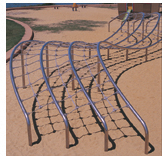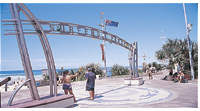If a job requires greater corrosion resistance than grade 304 can provide, grade 316 is the 'next step up'. Grade 316 has virtually the same mechanical, physical and fabrication characteristics as 304 with better corrosion resistance, particularly to pitting corrosion in chloride environments.
Grade 316 (UNS S31600) is the second most popular grade in the stainless steel family. It accounts for about 20% of all stainless steel produced.
 Composition
Composition
Table 1 compares three related grades - 316, 316L and 316H.
Grade 316L is a low carbon 316 often used to avoid possible sensitisation corrosion in welded components.
Grade 316H has a higher carbon content than 316L, which increases the strength (particularly at temperatures above about 500oC), but should not be used for applications where sensitisation corrosion could be expected.
|
Table 1 - Composition on 316 and related grades |
||||||||||
| Grade | C% | Mn% | Si% | P% | S% | Cr% | Ni% | Mo% | N% | |
| UNS 31600 | 316 | 0.08 | 2.0 | 0.75 | 0.045 | 0.03 | 16.0-18.0 | 10.0-14.0 | 2.0-3.0 | 0.10 |
|
Related Grades |
||||||||||
| UNS S31603 | 316L | 0.03 | 2.0 | 0.75 | 0.045 | 0.03 | 16.0-18.0 | 10.0-14.0 | 2.0-3.0 | 0.10 |
| UNS S31609 | 316H | 0.04-0.10 | 2.0 | 0.75 | 0.045 | 0.03 | 16.0-18.0 | 10.0-14.0 | 2.0-3.0 | - |
|
Both 316L and 316H are available in plate and pipe, but 316H is less readily available ex-stock. 316L and 316H are sometimes stocked as standard 316 (test certificates will confirm compliance with the 'L' or 'H' specification). |
||||||||||
Corrosion resistance
Grade 316 has excellent corrosion resistance in a wide range of media. Its main advantage over grade 304 is its increased ability to resist pitting and crevice corrosion in warm chloride environments. It resists ordinary rusting in virtually all architectural applications, and is often chosen for more aggressive environments such as sea-front buildings and fittings on wharves and piers. It is also resistant to most food processing environments, can be readily cleaned, and resists organic chemicals, dye stuffs and a wide variety of inorganic chemicals.
In hot chloride environments, grade 316 is subject to pitting and crevice corrosion and to stress corrosion cracking when subjected to tensile stresses beyond about 50oC. In these severe environments duplex grades such as 2205 (UNS S31803) or higher alloy austenitic grades including 6% molybdenum (UNS S31254) grades are more appropriate choices.
The corrosion resistances of the high and low carbon versions of 316 (316L and 316H) are the same as standard 316. They are mostly chosen to give better resistance to sensitisation in welding (316L) or for superior high temperature strength (316H).
Descriptions of these corrosion mechanisms are in ASSDA's Reference Manual.
 Heat resistance
Heat resistance
Like grade 304, 316 has good oxidation resistance in intermittent service to 870oC and in continuous service to 925oC. Continuous use of 316 in the 425-860oC range is not recommended if subsequent exposure to room temperature aqueous environments is anticipated, but it often performs well in temperatures fluctuating above and below this range.
Grade 316L is more resistant to carbide precipitation than standard 316 and 316H and can be used in the above temperature range. However, where high temperature strength is important, higher carbon values are required. For example, AS1210 Pressure Vessels Code limits the operating temperature of 316L to 450oC and restricts the use of 316 to carbon values of 0.04% or higher for temperatures above 550oC. 316H or the titanium-containing version 316Ti can be specified for higher temperature applications.
Like other austenitic stainless steels 316 has excellent toughness down to temperatures of liquefied gases and has application at these temperatures, although lower cost grades such as 304 are more usually selected for cryogenic vessels.
Physical and mechanical properties (see Tables 2 and 3)
|
Table 2: Mechanical properties of grade 316 (annealed condition) given in ASTM A240M |
Table 3: Physical properties of grade 316 typical values in annealed condition) |
|||
| Tensil strength |
515MPa min |
Density |
8,027kg/m3 |
|
| 0.2% proof stress |
205MPa min |
Elastic modulus |
193GPa |
|
| Elongation |
40% min |
Mean coefficient of thermal expansion |
||
| Brinell hardness |
217HB max |
0 - 100oC |
15.9µm/m/oC |
|
| Rockwell hardness |
95HRB max |
0 - 315oC |
16.2µm/m/oC |
|
|
Note: Slightly different properties are given in other specifications |
0 - 538oC |
17.5µm/m/ oC |
||
| 0 - 649oC |
18.6µm/m/ oC |
|||
| 0 - 815oC |
20.0µm/m/ oC |
|||
|
Thermal conductivity |
||||
| at 100oC |
16.3W/m.K |
|||
| at 500oC |
21.5W/m.K |
|||
| Specific heat 0 - 100oC |
500J/kg.G |
|||
| Electrical resistivity 20oC |
740 nOhm.m |
|||

Like other austenitic grades, 316 in the annealed condition is virtually non magnetic (i.e. very low magnetic permeability). While 304 can become significantly attracted to a magnet after being cold worked, grade 316 is almost always virtually totally non-responsive. This may be a reason for selecting grade 316 in some applications.
Another characteristic that 316 has in common with other austenitic steels is that it can only be hardened by cold working. An ultimate tensile strength in excess of 1,000MPa can be achieved and, depending on quantity and product form required, it may be possible to order to a specific cold-worked strength (see ASTM A666 or EN10088-2).
Annealing (also referred to as solution treating) is the main heat treatment carried out on grade 316. This is done by heating to 1,010 1,120oC and rapidly cooling - usually by water quenching.
Fabricability
Like other austenitic stainless steels, grade 316 has excellent forming characteristics. It can be deep drawn without intermediate heat softening enabling it to be used in the manufacture of drawn stainless parts, such as sinks and saucepans. However, for normal domestic articles the extra corrosion resistance of grade 316 is not necessary. 316 is readily brake or roll formed into a variety of other parts for application in the industrial and architectural fields.
Grade 316 has outstanding weldability and all standard welding techniques can be used (although oxyacetylene is not normally used). Although post weld annealing is often not required to restore 316's corrosion resistance, making it suitable for heavy gauge fabrication, appropriate post-weld clean-up is recommended.
Machinability of 316 is lower than most carbon steels. The standard austenitic grades like 316 can be readily machined if slower speeds and heavy feeds are used, tools are rigid and sharp, and cutting fluids are used. An 'improved machinability' version of 316 also exists.
Cost comparisons
The guidelines in Table 4 are approximate 'first cost' comparisons for sheet material in a standard mill finish suitable for construction projects. The appeal of stainless over its first cost competitors dramatically increases when lifecycle costs are considered.
|
Table 4: First cost comparisons |
|
| Material | Approximate Price ($/kg) |
| Glass (clear annealed) | 0.2 |
| Mild steel | 1.0-1.5 |
| Hot dip galvanised steel | 1.5-2.5 |
| 304 stainless | 4.0-5.0 |
| Aluminium alloy (extruded) | 4.0-5.5 |
| 316 stainless | 5.0-6.0 |
| Copper | 8.0 |
| Brass | 8.5 |
| Bronze | 10.0 |
|
Source: Facet Consulting Engineers, Brisbane |
|
Forms available
Grade 316 is available in virtually all stainless product forms including coil, sheet, plate, strip, tube, pipe, fittings, bars, angles, wire, fasteners and castings. 316L is also widely available, particularly in heavier products such as plate, pipe and bar. Most stainless steel surface finishes, from standard to special finishes, are available.
Applications
 Typical applications for 316 include boat fittings and structural members; architectural components particularly in marine, polluted or industrial environments; food and beverage processing equipment; hot water systems; and plant for chemical, petrochemical, mineral processing, photographic and other industries.
Typical applications for 316 include boat fittings and structural members; architectural components particularly in marine, polluted or industrial environments; food and beverage processing equipment; hot water systems; and plant for chemical, petrochemical, mineral processing, photographic and other industries.
Although 316 is often described as the 'marine grade', it is also seen as the first step up from the basic 304 grade.
Alternatives
Alternative grades to 316 should be considered in certain environments and applications including:
- strong reducing acids (alternatives might be 904L, 2205 or a super duplex grade),
- environments with temperatures above 50-60oC and with chlorides present (choose grades resistant to stress corrosion cracking and higher pitting resistance such as 2205 or a super duplex or super austenitic), and
- applications requiring heavy section welding (316L), substantial machining (an improved machinability version of 316), high strength or hardness (perhaps a martensitic or precipitation hardening grade).
Specifications
|
Table 5: Some approximate equivalent designations |
||||||
|
Wrought product |
||||||
| Standard | UNS | ASTM | British | German | Swedish | Japanese |
| Specification | S31600 | 316 | BS 316S16 En 58H, 58J |
W. No 1,4401 DIN X5CrNiMo 18 10 |
SS 2347 | JIS SUS 316 |
|
Cast product |
||||||
| Standard | UNS | ASTM | BS3100 | German | AS2074 | |
| Specification | J92900 | A743 CF-8M |
316C16 | STD 1,4408 DIN G-X6CrNiMo 18 10 |
H6B | |
|
Note: For fasteners manufactured to ISO3506, 316 is included in the "A4" designation. |
||||||